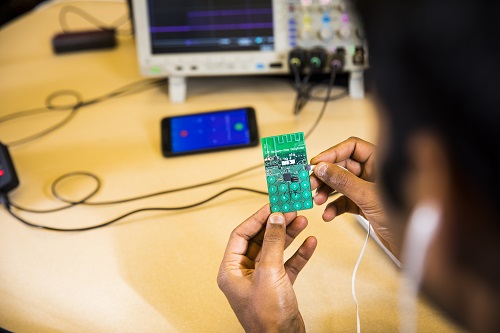
Image: Mark Stone/University of Washington.
By Brian Santo, contributing writer
It is easy to build a self-powering cellphone. Nobody has marketed one, however, because the challenge isn’t building a battery-free handset; it’s building a practical battery-free handset. Researchers at the University of Washington just got much closer to the mark with a prototype that harvests ambient radio signals and light to sustain the fundamental communication functions of a cellphone.
The U-Dub researchers built their handset entirely with commercial off-the-shelf (COTS) components and have demonstrated the ability to make a Skype call with it. They report that their phone can sense speech, actuate earphones, and switch between uplink and downlink communications, all in real time.
The prototype still has some drawbacks, but its development is an achievement, considering the hurdles. The researchers needed to create a design that could sustain an extended, uninterrupted conversation using just microwatts. That led to some interesting design choices.
Solar cells could deliver well in excess of a few microwatts, but they are considered too big and bulky to be practical. Other battery-free power sources include a set of sensors (such as accelerometers and humidity and temperature sensors) that all cycle far too slowly to provide continuous power for a mobile phone call, the researchers explain in their paper.
The researchers found two possible sources of continuous energy: light and RF power. They decided to include photodiodes and to harvest energy from the base station RF signal.
The RF energy harvester consists of a rectifier that converts the incident RF signal into low-voltage DC power. Photodiodes likewise output low-voltage DC. Whichever is used, signals are fed into a DC/DC boost converter, which increases the voltage to the 1.8 to 2.4 V required by the phone’s microcontroller and sensors, according to the paper.
The powering choices meant that the power budget for the phone would be only a few microwatts. That had ramifications for its design.
Mobile handsets have always depended on digital-to-analog and analog-to-digital converters. DACs and ADCs draw milliwatts, however, so the U-Dub researchers decided to ditch them.
Instead, the phone uses analog backscatter to transmit speech directly from a passive microphone and uses amplitude modulation to receive analog speech from the base station. The user must press a button on the handset prototype to toggle between transmitting and listening modes, but that function can be automated, according to the researchers.
The U-Dub scheme requires modifications to the base station, which has to transmit digital data by encoding information in the presence and absence of an RF carrier. “The phone uses an envelope-detector-based receiver to decode digital bits while consuming a few microwatts of power,” according to the paper. “The base station uses the Skype API to establish and manage connection with cellular networks. It implements a custom state machine to coordinate the connection between the cellular network and battery-free cellphone.”
The researchers believe that if battery-free phones based on their designs are commercialized, the necessary base station circuitry would be a cheap and easy addition to future Wi-Fi routers.
So far, the prototype phone has a range of 50 feet away from the base station when powered by photodiode, the researchers report, though the paper details several ways to extend the distance.
It would take a churl to point out that the phone can do little more than make calls (“What? I can’t troll through Facebook or play ‘Bejeweled’ with it?”), but there you have it.
Watch the video below from UW to see the battery-free cellphone in action:
Advertisement
Learn more about Electronic Products Magazine





